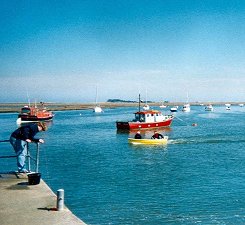
Wells is, in our own private dialect, ‘sticky’ – one of those towns that is very hard to leave once you’ve arrived there. Nevertheless if we’re to make Weybourne by this evening, one of the longer stages we have planned on this little walk of ours, we had better get on with it. You leave the town through a long sprawl of sheds and slipways that slowly sees civilization retreat and the marshes and sky start to dominate the landscape again. For the four miles or so between here and Stiffkey (formerly, and now rarely, pronounced ‘Stewkey’) the sea will be almost over the horizon but the scenery of creeks and mudflats will be so striking that you won’t miss it for a minute. It’s level, easy walking – one of the things that makes a stage this long a practical proposition. If you don’t fancy tackling it all in one go you can always break at Blakeney.
Webbun and Clai
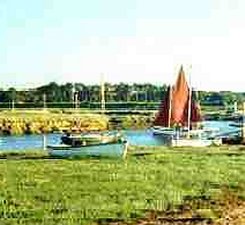
A little note here on pronunciations. In order to keep your credibility and not appear like a hapless tourist you need to be aware that our destination for this evening is Webbun and that the pleasant intermediate settlement with the windpump is Clai. We will not be visiting any village whose name rhymes with a child’s modelling material and a fine Home Counties enunciation of individual vowels and syllables is not the way to go about things here. Dew yew now say it proper. Although it is a sad fact that you can walk large stretches of this coast and be assailed with the strident accents of Chelsea’s finest dozens of times in a day, so fierce is the process of gentrification. But you’ll have precious little chance of hearing proper broad Norfolk. A bit of a shame, really. Oh well, on we go.
Morston and Blakeney
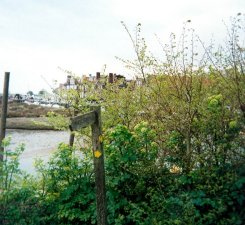
Stiffkey behind us and the landscape starts to get a bit more pleasant in the run-in to Morston, a gentle settlement of muddy creeks and dinghy sails ghosting about between the dunes. We haven’t really come far enough to justify lunch yet but this is otherwise a good refreshement stop. It’s longer than it looks from here to Blakeney – a frustrating walk along a grassy bank with the town constantly seeming on the verge of appearing round the next corner.
The retreating sea
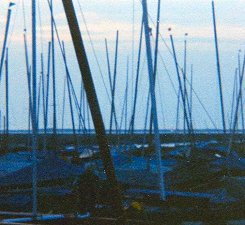
Once there, however, it is delightful – a bustling, nautical little place resounding to that weird ringing sound made by shrouds slapping against the metal masts of yachts if there is the slightest breath of wind. It’s sad in a way too – this was once a thriving port, now it’s virtually lost its sea access and the boats that do go out are mostly the yachts of wealthy second-homers from a town that exists almost entirely on tourism. There are interesting things to see – a church with a tall tower that was used as a beacon for shipping, the Watch House, an old coastguard lookout on the skyline, and the atmospheric brick undercroft of the Guildhall. Blakeney Point is a national nature reserve.
A short hop inland
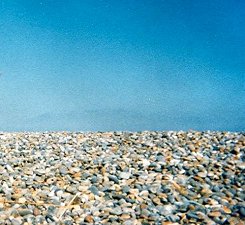
It’s now a short hop along and inland to Cley where we have to work hard not to get distracted by yet another picturesque village with a lovely beach. Leaving Cley we know that the real work of the day is now in front of us – a long slog along a shingle ridge running in front of Cley and Salthouse Marshes. We cut back out to the shoreline and then, as ever, the walker must choose which of the various options is likely to suit them best. You could walk at different points by the sea, on top of the shingle ridge (this is deprecated for fear of damaging the flood defences) or through the moonscape that runs behind it and each has its own advantages and disadvantages. Whatever you choose, be prepared for it to take a while and to use up a lot of energy. The sea rushes relentlessly over the pebbles and the air is full of salt spray. You’re almost certain to get a good breeze, although behind the ridge it can get very hot. There’s plenty of interest for those who like old salt workings and odd bits and pieces left lying around by the armed forces. As you close in on Weybourne Hope you begin to really appreciate how it got its name – but don’t forget that to get to your destination you still have to walk inland to the village. Whatever you do this evening – you’ve earned it. Enjoy it.